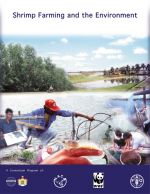Case studies in India on the role of small farmer groups and associations in sustainable shrimp aquaculture management (abstract)
23 November 2003 | M.N. Kutty, P. Ravichandran, M. Krishnan, M. Kumaran and C.P. Balasubramanian | 425 Downloads | .pdf | 11.01 KB | Better management practices, Livelihoods, gender and social issues, Shrimp, Environment and sustainability, India
The present case studies concentrated on three sites, Kandaleru in Andhra Pradesh, Dhigirpar in West Bengal and Brahmagiri in Orissa. The three sites are markedly different from each other.
Kandaleru is basically a system which came into being about two decades ago, with the renaissance of shrimp farming in India, breaking away from the age old traditional systems and putting a mark as a haphazardly developed, but highly profitable (at the boom time) cluster of farms, owned by a highly motivated group of farmers (in contrast to the shrimp farming communities in Brahmagiri and Dhigirpar), crowding around a brackishwater creek in India’s most active shrimp farming area (Nellore).
Dhigipar is a newly developed centrally organized farm complex site, situated in an open estuarine area of a large river, subject to high tidal fluxes with little chance for causing any pollution, but is yet to produce a commercially viable crop; and Braghamagiri site is located at the periphery of India’s largest closed water body, Chilka Lake, (actually a lagoon which opens into the sea through a narrow channel).
Brahmagiri clusters are the oldest organized shrimp farming units, which came into being through various Governmental programs such as ERRP and IADP and was successful at a modest level, involving small farmers including the very poor and socially backward communities, except for a few enterprising private shrimp farmers. The Brahmagiri clusters though located in the sensitive fringe area of the Lake, the shrimp farming practiced there using the “confined” pond system, which is solely dependent on rain water and has no exchange of water with the surroundings, and hence very eco-friendly.
The three sites have however a common feature that all three mainly are concerned with small farmers groupings, and are interested in development of sustainable shrimp farming. For the earlier shrimp farming failures owing to the overexploitation of the ecosystem, by overstocking and consequent high inputs, resulting in degradation of the environment, diseases and eventual collapse, have alerted all shrimp farm groups to be wary. A low input shrimp farm, adopting low-density stocking, often around 5 Pl/m2 or less is practiced in all the three sites.
Publisher: Network of Aquaculture Centres in Asia-Pacific
Rights: Copyright, all rights reserved.

